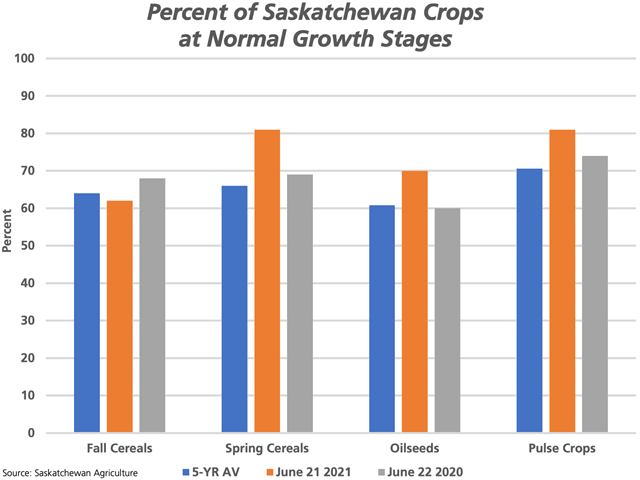Canada Markets
Saskatchewan's Weekly Crop Report
Rainfall across the province for the week ending June 21 ranged from trace amounts to less than 5 millimetres for most areas, although higher amounts fell in the far northwest of the province surrounding Meadow Lake, in the Prince Albert area and an area north of Yorkton, ranging from 10 mm to as high as 32 mm.
The province estimates cropland topsoil at 2% surplus, 56% adequate, 36% short and 6% very short. The area rated at 56% adequate is down from 72% last week, while the same rating as seen two weeks ago on the June 7 report. For the past five weekly reports, more than 50% of the province has been rated as having adequate topsoil moisture, ranging from 56% to 80% of the province during this period.
The area of the province rated short-to-very short topsoil moisture increased from 26% to 42% during the past week, close to the highest level seen in the past five weeks but still well below the high reported on May 17 of 80% of the province. The areas of the province rated short to very short are mostly seen from the West Central and East Central regions and south to the U.S. border, while the largest area is seen developing in the Southwest and West-Central regions.
P[L1] D[0x0] M[300x250] OOP[F] ADUNIT[] T[]
As seen on the attached chart, 62% of the winter wheat and fall rye crops are viewed at normal growth stages, below the same week in 2020 as well as the five-year average for this week. Early dry conditions saw the fall-seeded crops off to a slow start this spring.
At the same time, 81% of the spring cereals (66%), 70% of the oilseeds (60.8%) and 81% of the pulse crops (70.6%) are rated at normal growth stages for this week, with the five-year average in brackets.
While the percentage of the canola crop rated at normal stages is lower than the cereals and pulses, the rating remains higher than average for this week. Regional data shows only 65% of the canola crop in the East-Central and Northeast Regions at normal stages, while this estimate falls further to 58% in the West-Central Region, which also trails the other five regions given the ratings for cereals and pulse crops.
**
DTN 360 Poll
In advance of Statistics Canada seeded acreage report, due for release on June 29, what do you think will be the most obvious changes made to the acreage mix? You can weigh in with your ideas on this poll, which is found on the lower-right side of your DTN Homepage.
Cliff Jamieson can be reached at cliff.jamieson@dtn.com
Follow him on Twitter @Cliff Jamieson
(c) Copyright 2021 DTN, LLC. All rights reserved.






Comments
To comment, please Log In or Join our Community .